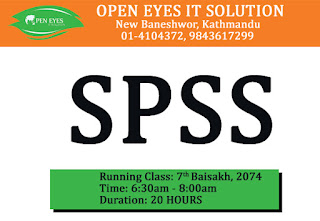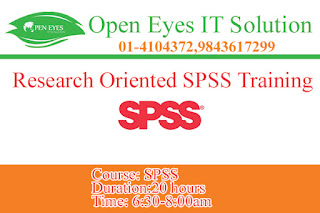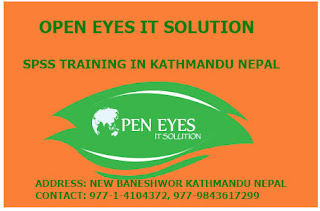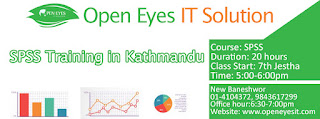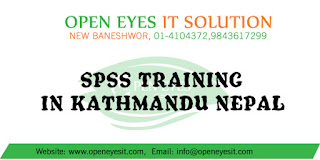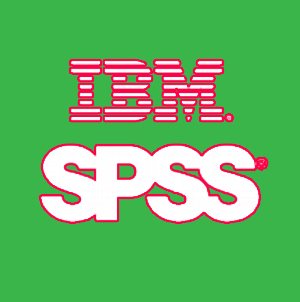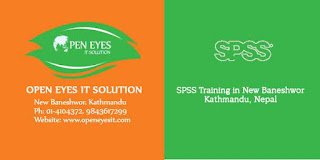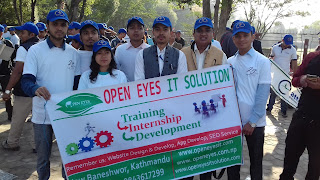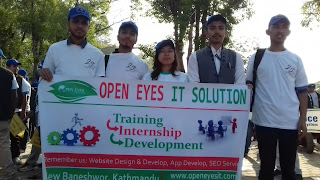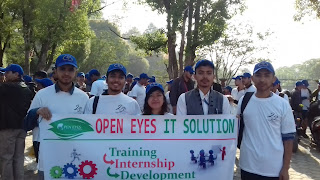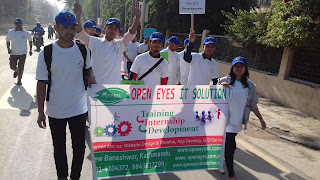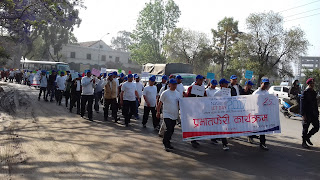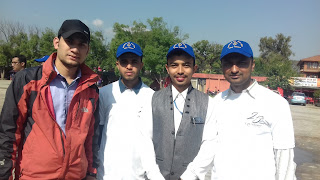SPSS (Statistical Package for the Social Sciences) training guides you through the fundamentals of research methods and statistics before moving on to the use of SPSS. SPSS is a powerful statistical application package from IBM used for analysis of data. The training delivers the skill related to the use of SPSS environment for data understanding, data preparation, and ways of executing sequence of operations to derive the result in the required format.
By the end of this training, you’ll be proficient in the following:
Understanding the research process and be clear in which type of data you must collect and how to measure it
Differentiating among different statistical models and types of results and errors
Familiar with SPSS environment
Know how to use SPPS to work with graphs
Exploring groups of data and making assumptions to work on a problem
Use SPSS forvarious statistical procedures such as Correlation, Regression, Dependent and Independent T-test, Pearson Chi-Square
Compare Means,and conduct post hoc test
Run several tests for statistical significance and interpreted the results
Target audience
Researchers
Data architects
Data scientist
Data analyst
Decision makers
Prerequisites
The candidates having basic knowledge of statistics and computers are ideal for this training.
1: Research methods
2: Statistics
3: SPSS Environment
4: Exploring data with graphs
5: Exploring assumptions
6: Correlation
7: Regression
8: Categorical predictor in multiple regression
9: Logistic regression
10: Comparing two means (t-test)
11: Comparing several means: ANOVA (GLM)
12: Chi-square
1: Research methods
Statistics?
The Research Process
Initial Observation
Generate Theory
Generate Hypotheses
Data collection to Test Theory
What to measure
How to Measure
Analyze data
Descriptive Statistics: Overview
Central Tendency
Measure of variation
Coefficient of Variation
Fitting Statistical Models
Conclusion
2: Statistics
Building statistical models
Types of statistical models
Populations and samples
Simple statistical models
The mean as a model
The variance and standard deviation
Central Limit Theorem
The standard error
Confidence Intervals
Test statistics
Non-significant results and Significant results:
One- and two-tailed tests
Type I and Type II errors
Effect Sizes
Statistical power
3: SPSS Environment
Accessing SPSS
To explore the key windows in SPSS
Data editor
The viewer
The syntax editor
How to create variables
Enter Data and adjust the properties of your variables
How to Load Files and Save
Opening Excel Files
Recoding Variables
Deleting/Inserting a Case or a Column
Selecting Cases
Using SPSS Help
4: Exploring data with graphs
The art of presenting data
The SPSS Chart Builder
Histograms: a good way to spot obvious problems
Boxplots (box–whisker diagrams)
Graphing means: bar charts and error bars
Simple bar charts for independent means
Clustered bar charts for independent means
Simple bar charts for related means
Clustered bar charts for related means
Clustered bar charts for ‘mixed’ designs
Line charts
Graphing relationships: the scatterplot
Simple scatterplot
Grouped scatterplot
Simple and grouped -D scatterplots
Matrix scatterplot
Simple dot plot or density plot
Drop-line graph
Editing graphs
5: Exploring assumptions
What are assumptions?
Assumptions of parametric data
The assumption of normality
Quantifying normality with numbers
Exploring groups of data
Testing whether a distribution is normal
Kolmogorov–Smirnov test on SPSS
Output from the explore procedure
Reporting the K–S test
Testing for homogeneity of variance
Levene’s test
Reporting Levene’s test
Correcting problems in the data
Dealing with outliers
Dealing with non-normality and unequal variances
Transforming the data using SPSS
6: Correlation
Looking at relationships
How do we measure relationships?
Covariance
Standardization and the correlation coefficient
The significance of the correlation coefficient
Confidence intervals for r
Correlation in SPSS
Bivariate correlation
Pearson’s correlation coefficient
Spearman’s correlation coefficient
Kendall’s tau (non-parametric)
Biserial and point–biserial correlations
Partial correlation
The theory behind part and partial correlation
Partial correlation using SPSS
Semi-partial (or part) correlations
Comparing correlations
Comparing independent rs
dependent rs
Calculating the effect size
How to report correlation coefficients
7: Regression
An introduction to regression
Some important information about straight lines
The method of least squares
Assessing the goodness of fit: sums of squares, R and R2
Doing simple regression on SPSS
Interpreting a simple regression
Overall fit of the model
Model parameters
Using the model
Multiple regression: the basics
An example of a multiple regression model
Sums of squares, R and R2
Methods of regression
How accurate is my regression model?
Assessing the regression model I: diagnostics
Assessing the regression model II: generalization
How to do multiple regression using SPSS
Some things to think about before the analysis
Main options
Statistics
Regression plots
Saving regression diagnostics
Interpreting multiple regression
Descriptive
Summary of model
Model parameters
Excluded variables
Assessing the assumption of no multicollinearity
Casewise diagnostics
Checking assumptions
What if I violate an assumption?
to report multiple regression
8: Categorical predictor in multiple regression
Dummy coding
SPSS output for dummy variables
9: Logistic regression
Background to logistic regression
What are the principles behind logistic regression?
Assessing the model: the log-likelihood statistic
Assessing the model: R and R2
The Wald statistic
The odds ratio: Exp (B)
Methods of logistic regression
Assumptions
Incomplete information from the predictors
Complete separation
Overdispersion
Binary logistic regression
The main analysis
Method of regression
Categorical predictors
Obtaining residuals
Interpreting logistic regression
The initial model
Step: intervention
Listing predicted probabilities
Interpreting residuals
Calculating the effect size
How to report logistic regression
Testing assumptions
Testing for linearity of the logit
Testing for multicollinearity
Predicting several categories: multinomial logistic regression
Running multinomial logistic regression in SPSS
Statistics
Other options
Interpreting the multinomial logistic regression output
Reporting the results
10: Comparing two means (t-test)
Looking at differences
A problem with error bar graphs of repeated-measures designs
Step : calculate the mean for each participant
Step : calculate the grand mean
Step : calculate the adjustment factor
: create adjusted values for each variable
The t-test
Rationale for the t-test
Assumptions of the t-test
The dependent t-test
Sampling distributions and the standard error
The dependent t-test equation explained
The dependent t-test and the assumption of normality
Dependent t-tests using SPSS
Output from the dependent t-test
Calculating the effect size
Reporting the dependent t-test
The independent t-test
The independent t-test equation explained
The independent t-test using SPSS
Output from the independent t-test
Calculating the effect size
Reporting the independent t-test
Between groups or repeated measures?
The t-test as a general linear model
11: Comparing several means: ANOVA (GLM)
The theory behind ANOVA
Inflated error rates
Interpreting f-test
ANOVA as regression
Logic of the f-ratio
Total sum of squares (SST)
Model sum of squares (SSM)
Residual sum of squares (SSR)
Mean squares
The f-ratio
Assumptions of ANOVA
Planned contrasts
Post hoc procedure
Running one-way ANOVA on SPSS
Planned comparisons using SPSS
Post hoc tests in SPSS
Output from one-way ANOVA
Output for the main analysis
Output for planned comparisons
Output for post hoc tests
Calculating the effect size
Reporting results from one-way independent ANOVA
Violations of assumptions in one-way independent ANOVA
12: Chi-square
Analysing categorical data
Theory of analysing categorical data
Pearson’s chi-square test
Fisher’s exact test
The likelihood ratio
Yates’ correction
Assumptions of the chi-square test
Doing chi-square on SPSS
Running the analysis
Output for the chi-square test
Breaking down a significant chi-square test with standardized residuals
Calculating an effect size
Reporting the results of chi-square



